Writing about Roger Sherman, the only man to sign our four most important founding documents – the Continental Association, the Declaration of Independence, the Articles of Confederation, and the Constitution – got me wondering why there weren’t more who had done so, and in particular why our most famous Founding Fathers hadn’t. I decided it might be useful to look at the signers of these instruments collectively. How many of them were there? What things did they have in common? What were their differences? What did they accomplish after signing? There are some surprises when we look at them as a group, plus a few “fun facts” for well-versed history fanatics to know.
In some respects, it is difficult to use such a comprehensive approach. Most books and articles available cover the signers of the Declaration or the signers of the Constitution and occasionally both.[1] These two for obvious reasons get the most attention, but the Continental Association is significant in that it got the ball rolling toward independence and the colonies speaking in a united voice. The Articles of Confederation, though known in retrospect as a first failed attempt at governance of the united colonies (now states), was intended be the instrument by which the new country would be run. Hindsight being what it is, we know it didn’t work, but that’s not to say it wasn’t important or taken seriously at the time. Some of the sources cited later in this piece will have made observations specific to the Declaration or the Constitution. Where appropriate, I will discuss the extent to which they apply to the other two.
For my analysis, I built a database of the signers of America’s four major founding documents, along with whatever demographic information I could acquire about each. I also extracted biographies of each person from the records of Biographical Directory of the United States Congress and put them together in one document. Slicing and dicing the data I was able to come up with some revealing numbers, and in reviewing the biographies I uncovered some surprising facts about particular signers. After a brief discussion of the documents involved and the meaning behind each one’s signing, we’ll get into what these analyses revealed.
The Documents
To set the stage, let me first lay out which four documents I’m talking about. Most, if not all, should be familiar. They are, in chronological order of date of signature:
- The Continental Association, signed 1774: This is the least known of the four. It was one of the first formal shows of unity among the colonies, though it was carefully worded not to criticize the King.[2] A direct result of “The Intolerable Acts,” it imposed a boycott on the import and export of goods among the thirteen colonies, Great Britain, and other British colonies.
- The Declaration of Independence, signed 1776: This hardly needs an introduction. It speaks for itself as a quintessential and iconic statement of the rights of man. Or, looking at it from a British perspective, as an act of treason (hence Franklin’s, if you will permit me, gallows humor, “We must all hang together, or most assuredly we shall all hang separately”). It can be viewed as a hypocritical statement from a bunch of slaveholders concerning liberty (it has no answer for British abolitionist Dr. Samuel Johnson’s biting question “How is it that we hear the loudest yelps for liberty from the drivers of Negroes?”[3]).
- The Articles of Confederation, signed 1777-1781: With independence declared, the Articles were issued to the states in November 1777 as the governmental structure for the fledgling United States,[4] though it was March 1781 before Maryland became the last state to ratify this document, officially making it the law of the land. It quickly became apparent that the Articles would not result in a viable republic, which necessitated the fourth document.
- The United States Constitution, signed 1787: The flaws in the Articles, to a large extent relating to its bias toward state’s rights and decision paralysis, became quickly apparent, necessitating a new governing document.
Throughout this article, the word “signer(s),” unless followed by reference to a specific document, refers to signers of any one or more of these four.
The first three of these documents were issued from the Continental Congresses, the first of which sat in 1774 (56 delegates) and the second in 1775-1787 (a total of 344 men serving as delegates at some point in that span with an average tenure of nearly three years).[5] The fourth stemmed from a convention technically called to revise the Articles. A total of 70 state delegates were invited. 55 attended the convention at various points, and only 39 signed the final product.[6] Reasons for non-signees are summarized in a table later in this piece. A total of 145 different men signed at least one of the four documents.[7]
What the Signatures Meant and When They Took Place
For the Continental Association, the signatories were identified by state. The only state not included was Georgia, which did not want to risk angering the British, whose help they were seeking in resolving some ongoing Indian conflicts. The signers were committing their states to a commercial action in response to the “Intolerable Acts.” Regardless of how much each state was impacted by those acts, they were committing to this venture together. It was an early show of solidarity between the states, coming from the First Continental Congress which in British eyes was an illegal assembly with no political authority.
Many books have been written about the Declaration, as well as the Constitution, and I won’t attempt to cover here all the ground they cover. I will say that knowing how things turned out, it is sometimes hard to understand the risk that the founders took by signing. They knew they were committing an act of treason and committing their “their lives, their fortunes, and their sacred honor.” This was no understatement, as a number of them were to find out.
To this point, much legend has arisen surrounding the fates of the Declaration’s signers, and indeed many faced some difficult times, though despite Franklin’s comment none met their fate at the end of a rope. Many allegedly faced torture, destruction of homes and property, etc. It is not clear whether they faced these things due to being signers or whether these were just random acts of war. It is also possible that events were exaggerated for purposes of either propaganda or to romanticize history afterward.
An article in the Journal of the American Bar Association on the 200th anniversary of the Declaration quotes one delegate a little more succinctly in expressing the solidarity behind this risk and commitment:
Philadelphia lawyer Thomas McKean, who represented and signed for Delaware, explained that signing was a kind of public loyalty oath and pledge of allegiance “to prevent traitors or spies from worming themselves among us” and that “no person should have a seat in Congress during that year until he should have signed the declaration of independence.” [8]
Interestingly, the names of the signers were not published until January 1777, delaying at least for a little while the personal risk they faced. At that time the word “unanimous” was added as the July 2 or 4 version was not unanimous and therefore did not make that claim. Despite our recognition of July 4 as Independence Day, the actual signing was a much more spread out event. Per an article in the journal Publius from July 1989:
On 15 July 1776, New York approved the Declaration, and an official signing was held on 2 August 1776. Only fifty men signed on that day, however. Five more added their names separately during the fall. Finally, on 18 January 1777, the Continental Congress authorized the printing of the Declaration, this time with the names of the signers included, although the fifty-sixth signature, that of Thomas McKeon, had not yet been affixed even by this date. Also, the word “unanimous” is added to the title of this version, which became the official version and is now prominently on public display in the National Archives building.[9]
As Jefferson himself admitted, the Declaration was more a collection of pronouncements from various sources versus breaking much new ground, but basically the signers were agreeing to a Lockean social compact, thus unanimity was important. [10]
The signers of the Constitution were putting something different on the line: their prestige in trying to secure ratification of an instrument that exceeded their original mandate. The names of the Declaration’s signers may have been delayed in their release, but the Constitution almost went out unsigned. On the final day of the Convention, North Carolina delegate Hugh Williamson proposed a motion that the document should not be signed, or at least not on its face. He moved that “the signing should be confined to the letter accompanying the Constitution to Congress which might perhaps do nearly as well, and would be found satisfactory to some members who disliked the Constitution.”[11] There is not a clear historical record of the reasoning behind this proposal, whether it reflected insecurity with the final product or some more esoteric legal purpose. In the end, the delegates moved to sign the document before releasing it, for a couple of reasons. First, the delegates’ signatures would function as a marketing device, highlighting important pro-Constitution selling points to the people who would ultimately determine its fate. Second, the signatures would function as a constraining device, preventing the Constitution’s signatories – all of whom carried considerable local influence – from publicly opposing the document once the ratification battles began.[12]
As far as the case for signing, Franklin, with his usual wit and insight, summed it up best:
It … astonishes me, Sir, to find this system approaching so near to perfection as it does; and I think it will astonish our enemies, who are waiting with confidence to hear that our councils are confounded like those of the Builders of Babel; and that our States are on the point of separation, only to meet hereafter for the purpose of cutting one another’s throats. Thus I consent, Sir, to this Constitution because I expect no better, and because I am not sure, that it is not the best.[13]
The Constitution’s signing subsequently took place quickly, with all signers affixing their names to the document during the afternoon of September 17, 1787. The Articles of Confederation, in contrast, acquired signatures over a long period of time and as individual states legally bound themselves to the document’s provisions.[14] The Articles, their signatures legally binding the states, were issued to the states on November 15, 1777, but the unanimous ratification required was not obtained until Maryland became the thirteenth state to sign in March, 1781, a span of nearly forty months touching five calendar years. The Constitution separated the signing of the document from its ratification (and used the power of those signatures to help secure ratification), while the signatures on the Articles were concurrent with legal ratification.
Statistical Analysis
Now that we’ve laid the groundwork, let’s look at how many signed each document and how much commonality there was among the signers of the four:[15]

For each, roughly half of the signers didn’t sign any of the other three. With these documents spread over a thirteen year period, you would expect a changing group of signers, and in fact this was the case.
For those people who signed each document and went on to sign another (or previously signed one), these are the documents they signed (subsequent charts will focus on the bolded numbers):

Only seven of the Association signers (about fourteen percent) ended up signing the Constitution, maybe not that surprising due to the thirteen year gap between the two. In other words, the cast of characters signing the Constitution was about eighty-six percent different from the group that started the whole process. Another figure that jumped out at me: only five signers of the Declaration also signed the Constitution. Certainly more than just the Declaration signers exerted influence on the Constitution. With the periodic debate through history as to whether we are (or should be) a nation that lives by the creed of the Declaration or the Constitution, the fact that the two only had five signers in common is perhaps an indication of the inconsistency between them. Later I will show you who the five common signers were.
Analysis
To some extent, the lack of common signers between 1776 and 1787 is due to mortality that changed the actors involved. The average signer lived to an age of just over sixty-four and a half years.[16] An analysis of the mortality rates starting from the original signers of the Continental Association shows the following:
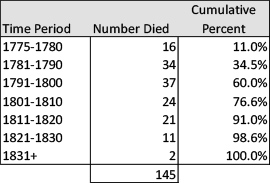
To break this down more finely, it can be expressed as to the signers of each individual document who were still alive to be able to sign the subsequent ones:

The conclusion is that, despite the relatively short average life span of the era, mortality was not a major factor in the discontinuity of signers. For example, there were forty-three Declaration signers still alive to potentially sign the Constitution, though only six did. Thus other factors came into play, such as the shifting political fortunes of the participants over the thirteen-year period between the two documents, as well as personal factors that may have caused earlier signers to be otherwise occupied when the future documents were put together. Collectively, seventy-eight percent of the signers of the first three were around for the Constitution, though of the ninety still alive (adjusting the figures above for men who signed more than one document), only eighteen would put quill to parchment for the Constitution.
As I noted earlier, questions come to mind about the consistency (or lack thereof) between the Constitution and the Declaration, and whether the former sufficiently reflects “the Spirit of ‘76” encompassed in the latter. This was at the root of the Federalist/Anti-Federalist argument during ratification, and still in some sense today underlies the arguments of “what kind of America” we should be. The table below lists the six signers the Declaration and the Constitution had in common. They were:

The Constitutional Convention included three other Declaration signers who could have but declined to sign the Constitution (Elbridge Gerry, Richard Henry Lee, and George Wythe). Their reasons are enumerated in a table later in this analysis. Additionally, there was one Declaration signer, Charles Carroll, who was invited to the Constitutional Convention but declined to attend.
Although Anti-Federalists argued that the Constitution broke with the principles articulated in the Declaration, Federalists could rely on the Constitution’s signatures (and references within it to independence) as visual cues to suggest that more than just the common signers believed the Constitution was consistent with the Revolutionary cause.[17] This is a variant on the prestige argument.
If you look at the overlap between signers of the Articles of Confederation and the Constitution you will find even fewer, only five, perhaps a good thing considering the lack of effectiveness of the Articles. They were:

Ironically, the two documents furthest apart in time, the Association and the Constitution, had the most signers in common with the latter, seven:
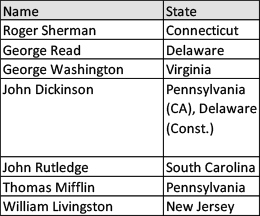
I mentioned that Roger Sherman was the only man to sign all four. Did anyone else come close to matching his feat? Well, surprisingly few (just six) even inked three of the four. Here is a list of those men, the one that got away, and why:

Depending on one’s political views, Samuel Adams and Richard Henry Lee may have proved prescient in their contention that the constitution enshrined too much power in the central government. The lack of a Bill of Rights was also a sticking point in the ratification of the Constitution, causing some not to sign and others to sign relying on the promise that one would be immediately added.
In talking about the signers of the Constitution, we spoke of the power and prestige of the signatures. Looking at all four documents, how big a factor was this? The core group of the most prestigious Founding Fathers (I have chosen six) wrote their figurative “John Hancock” just nine of a possible twenty-four times. Those six and the documents they signed are as follows:

What this illustrates is how many others were involved besides the most famous involved in the founding. It was a wide array of men who brought differing skills to bear. In a piece entitled “The World of the Founding Fathers,” historian and political scientist Saul K. Padover, writing in the journal Social Research in 1958, amplified this point in reference to the signers of the Constitution (though the same statement could be made for the other three documents), stating:
The answer [as to whether the framers were geniuses] is not to be found in any extremes. A few of the Founding Fathers, to be sure, were towering figures to whom the term genius has been applied [Franklin, Jefferson, and Washington]…Others were persons of uncommon talents as thinkers, writers, or orators [among them were John and Samuel Adams, Dickinson, Hamilton, Henry, Madison, and Mason]…
But the great majority, possibly four-fifths or more, were not particularly outstanding men. They were, rather, persons of generally average ability and character…In general, the Founding Fathers were what one may call solid citizens, respected by their neighbors, usually of good family and well-to-do.”[18]
This point is amplified when you look at a breakdown of the occupations of the signers, included later below.
Back to the “big name” founders: it should be noted that four of the six signed the Constitution, the document for which the prestige factor was specifically cited. The two that didn’t, Adams and Jefferson, were each overseas at the time, and almost surely would have been involved had they been in the country. Further, the fact that the most prominent of the founders signed only nine times out of a possible twenty-four does not in any way diminish the work these six men did in making the United States a reality. The men in the table above still did a heroic share of the “heavy lifting” of running a revolution and creating a republic. In fact, the reason many didn’t sign more is that they were out doing that heavy lifting. The following lists what caused them not to sign the ones they didn’t sign:
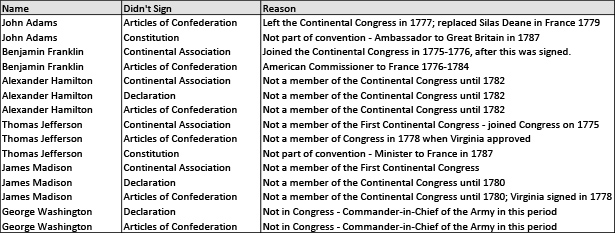
As this demonstrates, these were mainly situations of age and timing, often due to their being deployed elsewhere in roles critical to the success of the Revolution. Franklin was busy in Paris securing the critical treaty of alliance that would eventually tip the war in the patriots’ favor. Washington was busy fighting that war, leading the Continental Army as commander in chief. Adams and Jefferson, as previously mentioned, were deployed overseas at diplomatic posts. As I said, this is some “heavy lifting” that made the revolution a success.
While on the topic of non-signers, specific to the Constitutional Convention there were fifty-five attendees at the Constitutional Convention, of whom thirty-nine signed. Given the importance of that document, it’s worth noting the reasons those sixteen chose not to sign:
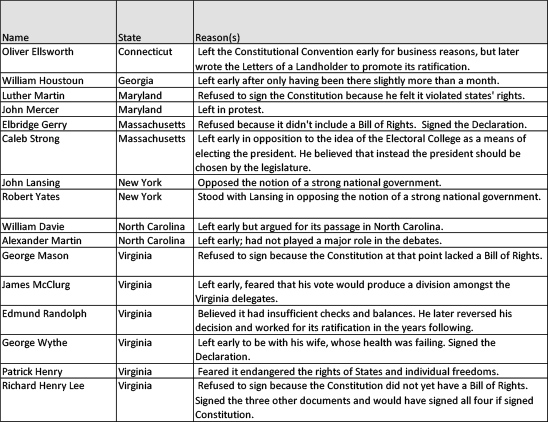
The majority, eleven of the sixteen, did not sign due to substantive disputes related to the content of the Constitution. Most of these related to concerns about the lack of a Bill of Rights or the increase in national governmental power, echoing the concerns of some of the “three of four” signers detailed earlier. The others left the convention for personal or business reasons. One interesting case is Richard Henry Lee, who if he had signed would have matched Roger Sherman’s accomplishment of signing all four documents, though it is doubtful he was thinking much about this potential statistical achievement amidst his concerns about the lack of a Bill of Rights. As mentioned earlier, three of the above were Declaration signers: Gerry, Lee, and Wythe.
A review of the signers on a state by state basis reveals some interesting anomalies when compared to population. It should be recognized that population figures for the late eighteenth century were derived via a variety of methods and levels of precision depending on the state, and as such they should be taken as rough estimates. The figures used here are from the U.S. Census website, and for purposes of the comparisons here I use the 1780 data. These include both whites and blacks, the latter as a full person and not the three-fifths that was used in the constitutional compromise (even if I had wanted to do this calculation, the data to do so was not available from this source, and I wanted consistency). Additionally, with thirteen states being an unwieldy number to use for charts, I aggregated the states into regions as follows:
- New England: Massachusetts, Connecticut, New Hampshire, and Rhode Island. Figures for Vermont and Maine (about 95,000 in total) were disregarded.
- Middle: Pennsylvania, New York, New Jersey, Delaware
- Chesapeake: Maryland, Virginia
- Southern: North Carolina, South Carolina, Georgia. Figures for Kentucky (45,000) were disregarded.
Signers by region are expressed as a percentage of total signers in the left-hand chart, while the absolute numbers are presented on the right (click to enlarge):[19]
The New England states and the Southern states were, with some variation by document, generally represented in line with their percentage of the population. Not so for the Middle and Chesapeake states, which were respectively over- and underrepresented. If population figures were adjusted for slave populations, these figures would fall more into line, the Middle states having relatively fewer slaves than the Chesapeake. Of course a similar adjustment to the Southern state population would leave them also overrepresented with respect to free populations. The percentages can also be skewed by the relatively small sample sizes (the small numbers in some state delegations).
Lastly, below is a look at the breakdown of the signers by primary occupation. As you would expect, the majority were lawyers, with only a few professional politicians. Many did more than one thing (for example, lawyer and soldier); to keep it simple I isolated their primary activity:

While a substantial number were lawyers, this breakdown supports the earlier comment about the signers representing a diversity of people and a number of “middling sorts.”
Other Signer Facts
One of the interesting things about reading or researching history is finding those obscure facts for which there is not really a category, just information you learn along the way about historical oddities or coincidences. In looking briefly into the lives of 145 different signers, a lot of this marginalia bubbled to the surface. If you, like me, are interested in knowledge of this sort, you’ve come to the right place. I’ll conclude this article with some of the information I garnered over the course of writing this, sure to help you win a bet or a trivia contest one day:
Many people know that Charles Carroll was the last living signer of the Declaration of Independence, but the final survivors for the other three are less well-known:

It is somehow fitting that the “Father of the Constitution”, James Madison, was the last signer to survive.
Additionally, the signers were widely spread by age. The honor of being the youngest and oldest for each document went to the following delegates:

To some extent, the founding became a family affair. Here are the various sets of relatives involved and which instruments they signed:
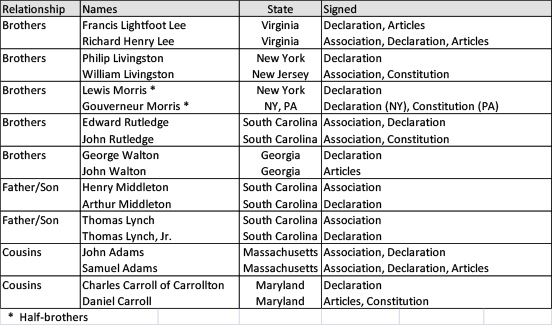
Other facts about the signers:[20]
- Signers became the first four Presidents of the United States: Washington, Adams, Jefferson, and Madison.
- Signers who became U. S. Supreme Court Justices: 6.
- Signers who became U.S. Senators: 19.
- Signers who became Governors: 32 (including one for Ohio Territories).
- Signers who became British prisoners during Revolution: 8 (including Articles signer Henry Laurens, captured at sea on his way to assume the post of U.S. Minister to Holland, imprisoned in the Tower of London and eventually exchanged for, of all people, Lord Charles Cornwallis).
- Signers later involved in duels: 3 (all three lost their lives, the most famous being Alexander Hamilton).
- Signers turned Loyalist: 2 (Joseph Galloway and Isaac Low, each signers of the Continental Association only). As a lobbyist for the Loyalists in Britain, Galloway was blamed by the pro-American side for unnecessarily prolonging the war.[21] Low also returned to the mother country and, feeling inadequately compensated for his losses and mistrusted because of his original role in the Continental Congress, retreated in despondency to the Isle of Wight, where he died at age fifty-six.[22]
- Signers impeached in future offices: 2 (William Blount as Senator from the new state of Tennessee – charges dismissed; Samuel Chase as Supreme Court Justice – not guilty).
- Signers lost at sea: 2 (Silas Deane returning from Europe where he had gone to secure papers to attempt to exonerate himself from a congressional investigation; France-bound Thomas Lynch, Jr.).
- Signers who signed on behalf of two states: Gouverneur Morris (Declaration for his home state of New York, Constitution for Pennsylvania), John Dickinson (Association for Pennsylvania, Articles and Constitution for Delaware).
- Foreign born signers: 16 (Ireland led with 7).
- Signers signing on behalf of states other than those of their birth: 51, including John Dickinson, born in Maryland but who signed for two: Pennsylvania (Association), and Delaware (Articles and Constitution). This number includes those born in foreign countries.
- Signers with college degrees: 48, including 3 from foreign institutions and one signer with two degrees (William Samuel Johnson of Connecticut). Ivy League schools accounted for 42 of the 48. Top school: Harvard with 12 signers.
- Robert Livingston, a member of the “Committee of Five” to draft the Declaration, was recalled by his state (New York) before he could sign, and as a result did not even sign the Declaration, though his cousin Philip did in his stead.
- John Collins, Rhode Island signer of the Articles, cast the deciding vote (as Governor) for Rhode Island’s ratification of the Constitution.
- Triple-signer Robert Morris, New York, “Financier of the Revolution,” spent three years in debtor’s prison, 1798-1801.
- Nathaniel Scudder, New Jersey, was killed in battle, October 1781, near Monmouth, New Jersey.
- George Wythe, Virginia, was allegedly poisoned to death by his mentally unstable great nephew.[23]
- John Jay, New York, Chief Justice of U.S. Supreme Court, negotiated and signed on behalf of the U.S. the co-called Jay Treaty, which was narrowly approved by Congress amid great controversy (leading Jay to joke that he could find his way from Boston to Philadelphia at night by the light of his burning effigies).
- Charles Cotesworth Pinckney, South Carolina, was part of the treaty commission involved in the XYZ Affair with France. After refusing to pay a bribe suggested by a French agent to facilitate negotiations, he was said to have replied “No! No! Not a sixpence!”
- Christopher Gadsden designed the iconic Gadsden Flag with the words “Don’t Tread on Me,” appropriated in recent years by the Tea Party.
Conclusion
So there you have it. A total of 145 men signed at least one of the four founding documents, though just one signed them all. Some were brilliant politicians, sophisticated political theorists, moving orators, and great leaders. Others were just middling, solid citizens doing the best they could and taking a brief turn on history’s stage. They accomplished big deeds, minor acts, and even some unusual exploits. Some went down in history while others have faded to obscurity. They combined to spur the revolution that some have called a miracle. All worked together to create these United States of America.
[1] I was able to locate one article containing a demographic analysis of the Declaration and Constitution signers only. See Richard D. Brown, “The Founders of 1776 and 1787: A Collective View,” William & Mary Quarterly, Volume 33, No. 3 (July, 1976), 465-480. There is better demographic information available on the signers of those two than on the Articles or especially the Association, so analyses of some of the variables used there, such as religions of the signers, would be incomplete. I could not locate anything discussing the signers of all four documents.
[2] National Archives Association, https://www.archivesfoundation.org/documents/1774-articles-association/, accessed June 29, 2017.
[3] James Boswell, Life of Samuel Johnson (London: Penguin Books, 1979), 363, Google Books edition, https://books.google.com/books?id=zb_xNmhncHAC&dq=life+of+samuel+johnson&hl=en&sa=X&ved=0ahUKEwjntKG3mrnVAhUCqFQKHS17D0YQ6AEIKDAA
[4] Library of Congress Webguides, https://www.loc.gov/rr/program/bib/ourdocs/articles.html, accessed June 29, 2017.
[5] Biographical Directory of the United States Congress, 1774-2005 (Washington, DC: Government Printing Office, 2005), https://www.gpo.gov/fdsys/pkg/GPO-CDOC-108hdoc222/pdf/GPO-CDOC-108hdoc222.pdf. Counted the number of delegates listed by state on pages 34-38. Excluded delegates who did not attend, of which there were ninety. Used each member’s service dates in the database described in Note 15 to calculate total average tenure.
[6] Delegates Who Didn’t Sign the Constitution, ConstitutionFacts.com, https://www.constitutionfacts.com/us-constitution-amendments/those-who-didnt-sign-the-constitution/, accessed June 29, 2017.
[7] Based on author’s analysis of the lists of signers of the four documents.
[8] Harry J. Lambeth, “The Lawyers Who Signed the Declaration of Independence,” American Bar Association Journal, Vol. 62, No. 7 (July, 1976), 870, http://www.jstor.org/stable/25727715.
[9] Donald S. Lutz, “The Declaration of Independence as Part of an American National Compact,” Publius, Vol. 19, No. 1 (Winter, 1989), Oxford University Press, 51, http://www.jstor.org/stable/3330564.
[10] Ibid., 58.
[11] Michael Coenen, “The Significance of Signatures: Why the Framers Signed the Constitution and What They Meant by Doing So,” The Yale Law Journal, Vol. 119, No. 5 (March 2010), 968, http://www.jstor.org/stable/20698315.
[12] Ibid., 971.
[13] Ibid., 973.
[14] Ibid., 978.
[15] Based on analysis done by the author. Lists of signers for the four documents were obtained, compared, and analyzed for commonality. The signer lists for the Declaration, Articles, and Constitution were obtained from the website Constitution Facts, https://www.constitutionfacts.com/. For the Continental Association, the information was obtained from https://founders.archives.gov/documents/Jefferson/01-01-02-0094. All accessed July 5, 2017.
[16] Based on author’s analysis of the birth and death dates of signers of the four documents, using the database described in note 15.
[17] Coenen, “The Significance of Signatures,” 1000.
[18] Saul K. Padover, “The World of the Founding Fathers,” Social Research, Vol. 25, No. 2 (Summer 1958), published by The New School Stable, 193-194, http://www.jstor.org/stable/40982556, accessed July 27, 2017.
[19] Signer by state data is from signer database referred to in other footnotes. Population data is from the U.S. Census Bureau website in a document entitled “Population in the Colonial and Continental Periods,” chart on page 9, https://www2.census.gov/prod2/decennial/documents/00165897ch01.pdf, accessed August 15, 2017.
[20] Unless otherwise specified, this information was all derived from an examination of the biographies of each signer found in the Biographical Directory of the United States Congress, 1774-2005. Reviewed the biographies of each signer found on pages 537-2218. Four signers were not included in this document: John Blair, David Brearley, Jacob Broom, and Charles Cotesworth Pinckney. Their biographies were found on the website America’s Founding Documents which contains biographies of the signers by state, https://www.archives.gov/founding-docs, accessed July 29, 2017.
[21] Maya Jasanoff, Liberty’s Exiles: American Loyalists in the Revolutionary World, Audiobooks Edition (Prince Frederick, MD: Recorded Books, 2012), 119 (page references derived from Google Books).
[22] Ibid., 138.
[23] Mary Miley Theobald, “Murder by Namesake,” Colonial Williamsburg Journal, Winter 2013, http://www.history.org/foundation/journal/winter13/murder.cfm, accessed August 16, 2017.




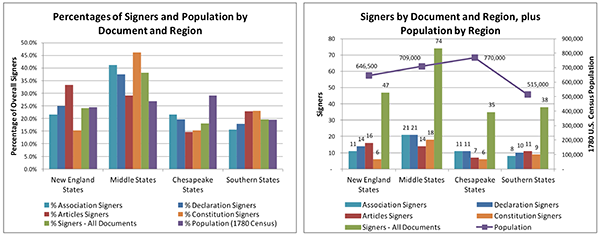
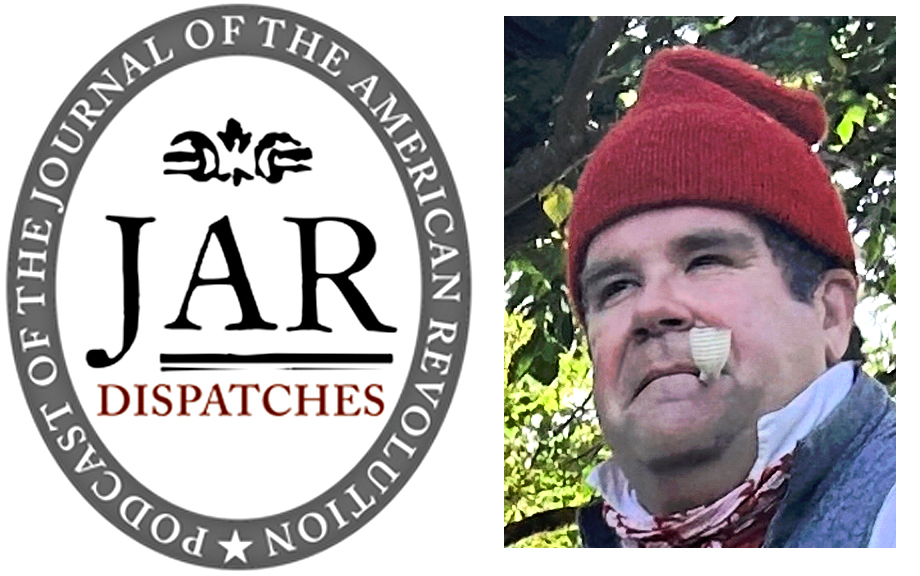
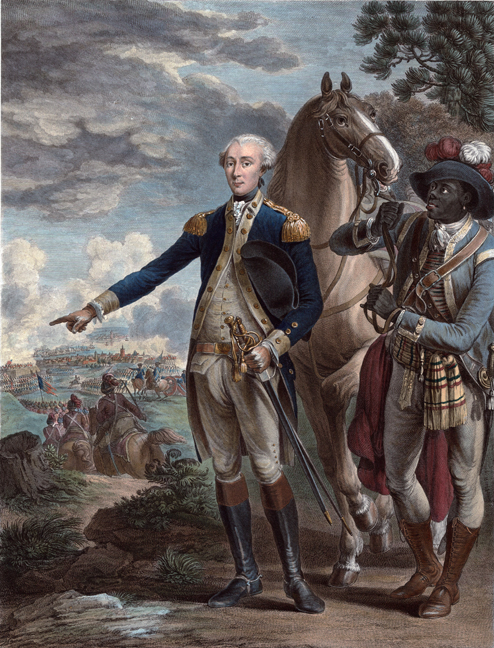
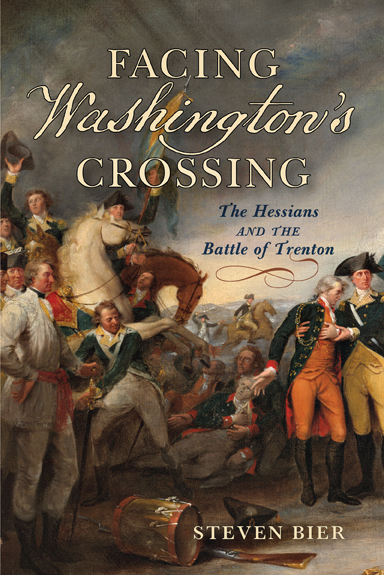

7 Comments
Richard,
This is an incredibly detailed analysis and a great contribution to the overall discussion. I was also wondering how many of them signed these documents based upon their individual desires to do so versus instructions received from their sending states. How many signed pursuant to these instructions and which might have gone against their personal desires? Or, how many attended these conventions and were simply given carte blanche to do as they thought best? Maybe I’m assuming too much involvement on the state’s part and they just left it all up to their respective representatives.
Hello Richard, This analysis is well done and very interesting and insightful. I just want to point out a typo. In the “Other facts about the signers section”…you noted Robert Morris as signing from New York. Robert Morris, the “Financier of the Revolution” who ended up in debtor’s prison signed for Pennsylvania.
Pamela –
You are correct, though I wouldn’t call that a typo. I’d call it an error. Thanks for the correction.
Had you continued on to ‘signers who went on to become generals,’ surely you would have stumbled upon the name of Gen. William Floyd, of Mastic, New York.
Jim –
I think I was tired by that time 🙂
Gary –
Thanks for the kind words. This article presented me with an opportunity to apply my CPA background and finally throw around some numbers and charts! As far as whether they were following state instructions or personal convictions, I hadn’t really thought of looking at that. I’m not sure the paper trail exists to make a comprehensive assessment of it. We do know of some cases where potential signers refused to sign and had the autonomy to do that; I’ve listed some of these in the article. In other cases, less men who disagreed could simply opt to not attend when invited, though only some of the non-attendees elected to do so for ideological reasons (others just had other commitments, etc.).
I’m working on something about the two men who DID sign but who we know disagreed with what they were signing. There may have been others, but these are the two most obvious. They are Joseph Galloway and Isaac Low, the two signers I briefly mentioned above who “went loyalist”. I will be trying to explain why they signed anyway (to your point, were state “marching orders” involved?) and talk about others who were close to joining them, at least by not signing (though maybe not by going as far as becoming loyalists). It’s funny how one piece has in it the seeds of another. I explained at the top how the Sherman article I wrote led to this one, now this one hopefully leads to the next.
I think on all of the four documents the level of agreement ran across a wide continuum, consistent with the founders being not one like-minded bloc, but people who had many different thoughts about how to get to the goal, or even on what the goal was. How much that was influenced by binding instructions from the states would be something to look at. I’d also be interested in regional differences in the level of buy-in to each document and, in cases where state delegations had autonomy, how much diversity of opinion there was within state delegations. This is stuff that’s more qualitative than quantitative, but might still be ascertainable. Lots of ways this can be sliced and diced, for sure. I had some other cuts that I didn’t use.
Richard,
As an avid reader of JAR and an Engineer, I have to say that I found your article to be fascinating … three huzzahs to you.
It was immediately apparent to me that the scope of your investigation was vast but you were very disciplined in staying “on message” even though there were obviously many rabbit holes that had to be very enticing. I see from your response to Gary that you’re planning to go down a few of those holes in the near future … I can’t wait.
For me, the rabbit hole about the Founder’s religious affiliations, which you mentioned, is of particular importance if one were to try to determine what cultural and socioeconomic similarities they had in common … what “bound” them together. Although the subject may be controversial, I believe their spiritual beliefs is an essential part of the founders 18th century American culture … I found this website to be informative http://candst.tripod.com/tnppage/qtable.htm as a place to start and maybe you’ve already seen it.
Again, I’m looking forward to your next article.
Roy